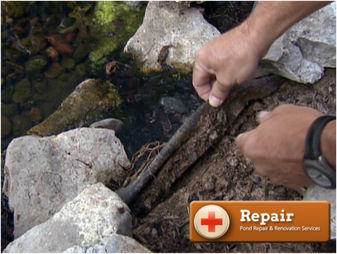LEAK!
The four letter word that a pond owner fears.
Don’t worry, it’s not the end of the world. In fact, most backyard ponds can lose 1 to 2 inches of water a week to evaporation. This will depend on the amount of sun exposure and the volume of water flowing over your waterfalls. If you have a lot of both you may have a larger than normal amount of water loss due to evaporation.


Now, that doesn’t mean that if you fill your pond up to the normal level one day and then you see that the level has dropped 5”-6” the next day that you are dealing with normal evaporation. At that point you can rule out evaporation and assume that you are dealing with a leaking pond.
LOW EDGES:
The first thing you want to do is look for any low edges in your pond/waterfall liner. The most common cause of a leak is a low edge in the waterfall due to settling of the soil underneath the liner. Another area where you can find a low edge could be along the perimeter of your pond. Start by going over the edges of your whole pond including your waterfalls and stream. There could be areas where the dirt has settled and the liner has dropped below the water level.
An easy way you could find these spots is by looking for wet mulch or muddy areas around your water feature. If you find a spot like this around your pond, all you need to do is raise the liner above the water level. Simply lift the liner up and pack some soil under the liner in the area to raise it up. Leak Fixed!
OBSTRUCTIONS IN THE STREAM AND SKIMMER
Another thing you should check for in the stream and near the pond skimmer is an excess buildup of debris, algae growth or rocks that have shifted and are blocking water flow. These obstructions can divert the water flow over the liners edge, and also raise the water level in areas where the liner is too low. Simply moving the obstruction should alleviate the problem. Algae and Debris can be controlled by maintaining your water feature and trimming back any excess growth.
TRIED THESE STEPS, BUT MY POND IS STILL LEAKING!!
So, you have spent at least 20 minutes or so looking for the easier, tell-tale signs of a leak to no avail. Now it’s time for you to start digging a little deeper…
THE 24 HOUR LEAK TEST
Before you start digging up your pond and searching aimlessly for the source of the water loss, you’ll want to determine if the leak is in the waterfall or in the pond by following these steps to eliminate the pond from the equation:
-Make sure the pond is filled to the normal operating level.
-Unplug the waterfall pump(s)
-If you have fish, you’ll want to install a bubbler pump or sub-surface aeration during this test.
-Take note of the pond level and let the pond sit with the waterfall turned off for 24 hours
-If the water level remains the same after 24 hours, then you can assume the pond is in good shape and not leaking.
THE WATER LEVEL IN THE POND IS DROPPING
If the water level in the pond continues to drop, allow it to continue until its stops. You may need to remove your fish from the pond at this point and house them in temporary holding tank(s) with aeration). The level where the water stops dropping is where you are going to start looking for your leak.
THE WATER LEVEL IN THE POND IS HOLDING STEADY
If you have determined that the pond is not the source of your leak, the next thing you will want to do is go ahead and check the plumbing, connections and your waterfall/stream. At this point you may want to consider calling a Pond Professional, but if you feel comfortable with proceeding on your own with you fish pond leak, check out our videos and blogs on Advanced Pond Leak Detection or Advanced Waterfall Leak Detection
We know it is not fun when your pond is losing water, but if you take the time to follow these simple pond leak repair steps, you could possibly find the problem yourself. If you live in the Northern New Jersey area and need the assistance of a Master Certified Aquascape Contractor, be sure to contact us at Atlantis Water Gardens via our website contact page or give us a call at (973)-627-0515 and we will be happy to see if we can help!
If you’d had enough, and don’t even feel like reading or searching for more info, just give us a call. We’ll help you out.
This is an article from our Learning Hub. Want to learn more tips and tricks about water gardens?
Learning make you tired?
Don’t worry. Here’s some pretty photos you can look at to destress.

Founder & Master Pond Builder
Jaak Harju is the founder and master pond builder of Atlantis Water Gardens, a family-owned design and build firm specializing in natural-looking ponds, waterfalls, and ecosystem water features. Since 2000, Jaak has dedicated his career to creating outdoor environments that inspire connection with nature.
With a background in landscape design and construction, Jaak brings artistry and precision to every project. He’s known nationally for his creative stonework, ecological pond design, and educational outreach within the pond-building community. Through his work, videos, and collaborations with other Aquascape-certified contractors, Jaak has helped redefine backyard water features as sustainable, living ecosystems.